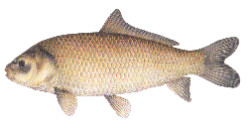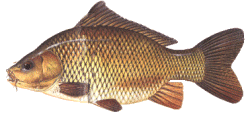
Carp, Drum & White Amur

Also called sheepshead, the drum emits a grunting, or drumming, noise with special muscles that vibrate against the swim bladder. Although the breeding habits of the drum are unknown, the grunting is assumed to be a part of this ritual. The drum's otoliths, or ear bones, are large and much like ivory. A small "L" shaped indentation is visible on the otolith, and some fishermen consider them lucky charms. Drum are commonly caught on nightcrawlers and lures, especially by walleye fishermen. Their meat is white and tasty.

The bigmouth buffalo has become abundant in many reservoirs. The buffalo feeds on plankton and is considered a rough fish since it is rarely caught on hook and line. With an angled sucker mouth, the buffalo doesn't feed on the bottom. At one time; it was an important commercial fish and is still taken by commercial netters for fish markets. The buffalo prefers deep, still pools and can become quite numerous in oxbows and reservoirs. When they become too numerous, the department occasionally contracts commercial fishermen to net buffalo and other rough fish. Removing large numbers of rough fish can improve conditions for sportfish.

The common carp is an introduced species. Brought to the U.S. from Asia in the late 19th century. Originally stocked for a sportfish, the adaptable carp was soon considered a nuisance. It is tolerant of a wide of water conditions and is so prolific it can crowd out native fish. Carp are common in nearly all waters, especially rivers, streams and reservoirs. It feeds mostly on invertebrates and green plant Material. Anglers use dough baits or corn to catch carp, and it is a spectacular fighting fish when caught on hook and line. Intermuscular bones make the meat less desirable.

The white amur, or grass carp, is an introduced species brought over from Asia. A vegetarian, the grass carp has been mainly stocked in the U.S. to control aquatic vegetation. It has been widely stocked for this purpose. However, care should be taken when stocking since some vegetation is necessary for a healthy fishery. Grass carp get big and are extremely powerful swimmers. Recently, angling interest has picked up in catching them on small flies imitating bits of vegetation has grown. Hooking a large grass carp is an angling experience not soon forgotten.